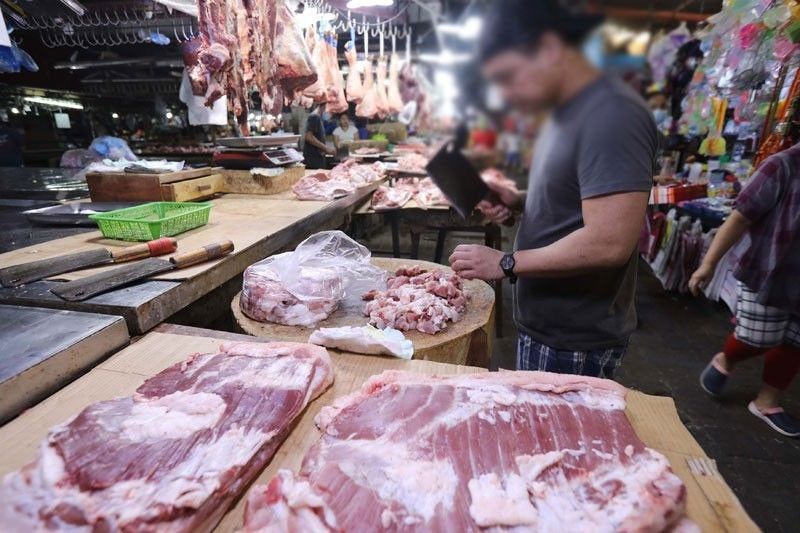Higher pork, chicken imports seen this year

MANILA, Philippines — The Philippines is expected to double the volume of pork imports from the global market this year amid a shortfall in supply due to the African swine fever (ASF), as well as the adjustments to the country’s tariff rate system.
In the latest report of the United States Department of Agriculture (USDA)-Foreign Agricultural Service, the Philippines is seen to import 350,000 metric tons (MT) of pork this year, more than double last year’s 167,000 MT.
The figure is higher than the 200,000 MT pork imports projected in January.
Domestic pork consumption is forecast to rise to 1.35 million MT this year. However, the country’s production is projected to decline by 10 percent to one million MT.
In contrast, global pork production is expected to rise by five percent to 101.5 million MT as China and Vietnam recover from ASF.
“Global exports are forecast to decline one percent to 11.5 million MT from the 2020 record as import demand from China slows and more than offsets growth from the rest of the world,”the USDA said, adding that China imports are seen to drop by eight percent due to recovering production.
“On the other hand, the Philippines is expected to see imports more than double amid a domestic pork supply shortfall and changes to its tariff rate quota system,” it said.
Last week, President Duterte signed Executive Order (EO) 128, which approves the Department of Agriculture (DA)’s proposal to adjust the most favored nation (MFN) tariff rates for both in-quota and out-quota imports for pork over a one-year period.
Under the EO, in-quota or those within the minimum access volume (MAV) will be slapped with a five-percent tariff which will be imposed for the first three months and will be increased to 10 percent from the fourth to 12th month.
Prior to the EO, imports under MAV are charged a 30-percent tariff.
For those outside MAV, a 15 percent tariff will be imposed for the first three months and will be raised to 20 percent from the fourth to 12th month. This is lower than the 40-percent tariff prior to the EO.
The original tariff rates will be returned a year after the EO’s effectivity.
The adjustment in tariff rates was made in a bid to address the existing pork supply shortage, stabilize price of pork meat and minimize inflation rates.
Duterte has also recommended to Congress the increase in MAV by 350,000 MT to address the shortfall in pork supply.
Moreover, the USDA said the Philippines is also expected to buy more chicken meat from the global market this year.
The country is expected to import 350,000 MT of chicken meat this year, higher than last year’s 335,000 MT.
The projection, however, is lower than the USDA’s earlier forecast in January of 400,000 MT.
For this year, the USDA is expecting global chicken meat production to rise by one percent to 102 million MT.
Similarly, global exports are forecast to grow by one percent to 12 million MT.
The USDA is also projecting global chicken meat consumption to slightly increase to 100 million MT from 98.7 million MT in 2020.
Meanwhile, the transport of hogs to Metro Manila markets to augment supply and stabilize pork prices continues despite the lifting of the price cap on Friday, according to the Department of Agriculture (DA).
Data from the DA shows that 6,476 hogs and 35,391 kilos of carcasses were delivered to markets in Metro Manila on April 9, the day that the price ceiling was lifted.
This brought the total hog deliveries in over two months to 280,621 hogs and 1.85 million kilos of carcasses delivered to the National Capital Region (NCR) by local hog raisers from Feb. 8 to April 8.
Calabarzon (Cavite, Laguna, Batangas, Rizal and Quezon) supplied the biggest number of live hogs, accounting for 46.6 percent of total deliveries.
This was followed by Western Visayas with 19.77 percent; Mimaropa (Mindoro, Marinduque, Romblon, Palawan) 11.86 percent; Bicol 7.76 percent and Soccsksargen (South Cotabato, Cotabato City, Sultan Kudarat, Sarangani, General Santos) 6.69 percent.
Hog shipments were also made from other regions such as Central Luzon, Northern Mindanao, Zamboanga peninsula, Central Visayas, Northern Mindanao, Ilocos and Cagayan Valley.
Central Luzon shipped the largest volume of carcasses, accounting for 98.09 percent.
The DA was looking to deliver at least 15,000 hogs per week to Metro Manila for two months to stabilize pork prices.
It was to complement a 60-day price cap on pork and chicken products in Metro Manila markets under Executive Order 124 which ended last April 8.
The EO was implemented with guidelines issued by Agriculture Secretary William Dar whereas the price ceiling was set at P270 per kilo for kasim or pork shoulder, P300 for liempo or pork belly and P160 per kilo for chicken.
While the price ceiling has already been lifted, Dar said the DA would continue to encourage hog raisers to supply and deliver surplus hogs from ASF-free provinces in Luzon, Visayas and Mindanao.
- Latest
- Trending



























